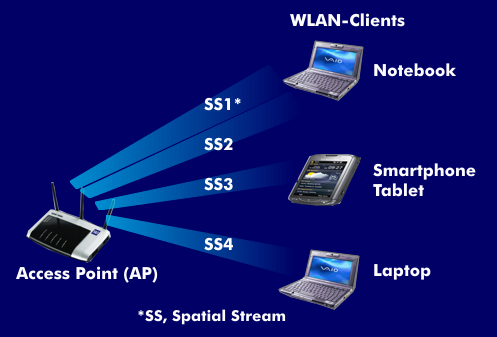spatial stream (SS)
With MIMO technology, the access point sends several independent data streams. Each data stream is called a spatial stream(SS) because it uses different paths through the room and transports the same or different data over them to the receiver or WLAN client. Depending on the WLAN concept, a transmitter can support two, four or even eight spatial streams. WLANs based on 802.11n support a maximum of four spatial streams, and 802.11ac even eight.
The number of spatial streams is decisive for the data rate. Each spatial stream contributes to the increase in the resulting data rate with the basic data rate. For example, the data rate of 802.11n at a bandwidth of 20 MHz is 72 Mbit/s with a single spatial stream, doubling to 144 Mbit/s with two spatial streams, and doubling further to 288 Mbit/s with four spatial streams.
Spatial Stream can be used not only to increase data throughput and signal-to- noise ratio, but also for simultaneous data transmission to multiple clients, as in Multi-User MIMO( MU-MIMO). Multi-stream operation is much more computationally expensive than single-stream operation because multiple spatial streams must be combined in one transmission. The number of spatial streams cannot be greater than the number of antennas in the antenna array. If the number of antennas exceeds the number of spatial streams, then the remaining spatial stream can be used to improve the signal-to-noise ratio.

